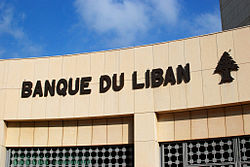This article needs additional citations for verification. (September 2024) |
 | |
| Headquarters | Beirut, Lebanon |
|---|---|
| Established | August 1, 1963 |
| Ownership | 100% state ownership[1] |
| Governor | Wassim Manssouri (acting) |
| Central bank of | Lebanon |
| Currency | Lebanese Pound LBP (ISO 4217) |
| Reserves | $14.7 billion |
| Bank rate | 2.75% |
| Interest on reserves | 4.00% |
| Website | www |

Banque du Liban (Arabic: مصرف لبنان; English: Bank of Lebanon) is the central bank of Lebanon. It was established on August 1, 1963, and became fully operational on April 1, 1964. In 2023, Wassim Mansouri stepped up as interim governor of the Banque du Liban after Lebanon failed to name a successor to Riad Salameh, whose term finished in July 2023.[2] Salameh, who was chairman for 30 years, has been accused of corruption, money laundering and running the largest Ponzi scheme in history; he was additionally labeled "the world’s worst central banker".[3][4][5] He is currently under sanctions by Canada, the United Kingdom and the United States.[6]
One of the main responsibilities of the bank is issuing Lebanon's currency, the Lebanese Pound. Other responsibilities include maintaining monetary stability, regulation of money transfers, and maintaining the soundness of the banking sector. Banking is a very important part of Lebanon's economy with over 100 different banks, which makes the role of BdL particularly important. It currently owns 99.37% of the shares of Lebanon's national carrier, Middle East Airlines.[7] The BdL is also the dominant shareholder of the Intra Investment Company (IIC), which in turn owns 53% of Casino du Liban, making it the only central bank worldwide to rule over a Las Vegas–style gambling casino.[8]
Besides the main branch in Beirut, it has branches in Aley, Baalbeck, Bikfaya, Jounieh, Nabatiye, Sidon, Tripoli, Tyre, and Zahlé.
- ^ Jan Weidner (2017). "The Organisation and Structure of Central Banks". Technische Universität Darmstadt. p. 233.
- ^ "Lebanon: Interim Central Bank Governor Steps up". 31 August 2023.
- ^ "France opens probe into personal wealth of Lebanon's central bank chief". France 24. 6 June 2021. Retrieved 12 July 2021.
- ^ Enders, David. "Lebanon central bank governor summoned for questioning by judge". www.aljazeera.com. Retrieved 12 July 2021.
- ^ "The world's worst central banker retires". The Economist. ISSN 0013-0613. Retrieved 2 August 2023.
- ^ "US, UK and Canada sanction Lebanon's former central bank governor".
- ^ "La MEA dévoile les nouveaux équipements de son centre de formation". L'Orient Le Jour. 2017-11-02.
- ^ Berthier, Rosalie (2 May 2017). "Abracada...broke - Lebanon's banking on magic". www.synaps.network. Archived from the original on 2020-07-05. Retrieved 2021-11-16.